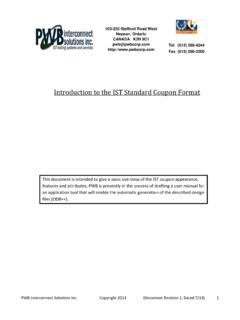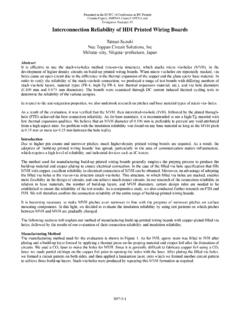Transcription of IPC-TM-650 TEST METHODS MANUAL
1 1 ScopeThis test measures changes in resistance ofplated-through hole barrels and internal layer connections asholes are subjected to thermal cycling. Thermal cycling is pro-duced by the application of a current through a specific cou-pon this technique, the test coupon is resistance heated bypassing DC current through the internal layer connection tothe barrel for three minutes to bring the temperature of thecopper to a designated temperature. Switching the current onand off creates thermal cycles between room temperatureand the designated temperature within the sample.
2 This ther-mal cycling induces cyclic fatigue strain in the plated-throughhole barrels and internal layer interconnects and acceleratesany latent number of cycles achieved permits a quantitative assess-ment of the performance of the entire information regarding the test is found in Section Applicable DocumentsIPC-TM-650 Test METHODS - Semi or Automatic Technique3 Test SpecimensA typical daisy chain test coupon isshown in Figure IST CouponCertain design rules must be applied toachieve thermal uniformity. Electronic design files for couponconstruction are available from the IST test system coupon resistance should measure between 150 millio-hms and ohms when measured at elevated resistance values (voltage drops) for each coupon aremonitored independently, using a four wire test coupon(s) is incorporated on the panel to monitor orqualify design, materials or processes and provide riskassessment of product and/or reliability Apparatus or Stress Test System (IST) or SYSTEM DETAILSThis equipment is available from.
3 PWB Interconnect Solutions Stafford Rd W Unit 105 Nepean, Ontario Canada K2H 9C1(613)-596-4244 URL: (2) four-pin, mm [ in] pitch male connectors(MOLEX 2241-4042 or equivalent) or Sn63Pb37 - Imaging equipment - optional5 Sample two four-pin male connectors in the mm[ in] holes at left and right edges of side one (1). A sol-der fillet must be apparent on both sides of the coupons to come to room temperature (approxi-mately 10 minutes), prior to installation onto IST IST coupons at each test head by attaching maleto female 12215 Sanders RoadNorthbrook, IL 60062-6135 IPC-TM-650 TEST METHODS Current Induced Thermal Cycling TestDate05/01 RevisionOriginating Task GroupTest METHODS Subcommittee (7-11)Material in this Test METHODS MANUAL was voluntarily established by Technical Committees of IPC.
4 This material is advisory onlyand its use or adaptation is entirely voluntary. IPC disclaims all liability of any kind as to the use, application, or adaptation of thismaterial. Users are also wholly responsible for protecting themselves against all claims or liabilities for patent referenced is for the convenience of the user and does not imply endorsement by CONNECTINGELECTRONICS INDUSTRIES system software with specific test available ranges and typical conditions are as follows:ConditionsIST RangeDefaultNo. of samples1-66 Test Temp50 C to 250 C[122 F to 422 F]150 C(302 F]Max. Res. Chng1-100%10%Max.)
5 No. Cycles1-4000250 (1 day)Data Coll. cycles10 cyclesCooling heat Pre-Cycling Test SequenceThe following para-graphs detail the sequence for a single coupon, however thissequence is done at all test heads simultaneously. The ambi-ent resistance, target temperature resistance, rejection resis-tance and current is calculated for each coupon and displayedon the PC : Handling the coupons will raise the temperature ofthe coupon and may affect the ambient resistance calculationduring the pre-cycling sequence. If the ambient temperatureof the coupons is in question, cool the coupons with the fanson the IST equipment for one to two Ambient ResistanceThe auto ranging multimetermeasures the ambient resistance (voltage drop) of the cou-pon.
6 This is the circuit that heats the coupon with DC Target Temperature ResistanceThe systemsoftware calculates and displays the required target resis-tance (temperature). The available stress testing range is from50 C - 250 C [122 F - 422 F]. The equation used to calculatethe target resistance is as follows:Target Resistance = Rrm(1 + T[Th-Trm])where: T= Estimated thermal coefficient of resistance for the inter-connectRrm= Resistance of coupon at room temp (approximately25 C [77 F])Th= Specified temperature to be Room Rejection ResistanceThe rejection resistance iscalculated and displayed.
7 This is adjustable from a 1% to a100% increase. If 10% is selected, 10% of the target resis-tance is calculated and added to the original resistance toestablish the rejection CurrentThe system selects an initial current basedon the ambient resistance of the coupon and the currenttable. The current tables are derived from software libraries onthe IST equipment. During the pre-cycling sequence, the ini-tial current is adjusted for each coupon to assure the testtemperature resistance is achieved in three minutes threeseconds (see paragraph ).NOTE.
8 Additional equations/algorithms used by IST thatestablish the initial current selection for pre-cycling, relative tothe relationship of coupon interconnect resistance T, couponconstruction and stress test temperature to be achieved areconsidered proprietary at this is initiated by the application of theselected current to the coupon, the computer monitors andrecords the coupon s performance throughout this first at the end of the first pre-cycle, the coupon achieves thespecified resistance level in three minutes three seconds, itwill be accepted for subsequent stress testing.
9 If the resis-tance level was not achieved in this time frame, the couponwill automatically be pre-cycled again with a revised or com-pensated current. The system will re-test using revised condi-tions until all coupons are accepted or rejected for stress : The equation/algorithms used by IST to compensatethe DC current is considered proprietary at this air cooling is commenced after each pre-cycle to cool the coupons. (Requires three minutes.) system automatically records and saves allinformation regarding conditions for subsequent stress the pre-cycle sequence is complete, the ISTsystem begins the thermal cycling of the coupons.
10 The ISTsystem continuously monitors the coupons and records therelative changes in resistance of both the barrel and the inter-nal layer connections. Data is compiled for each coupon sperformance throughout IST stress testing. The system soft-ware provides a download file to graph the coupon s perfor-mance. Data is compiled to create graphs of each coupon sperformance throughout IST stress Current Induced Thermal Cycling TestDate05 Microsection Evaluation - OptionalIf detailed failureanalysis is desired to determine exact location of separationsand/or cracks, then a multimeter or a thermal imaging systemcan aid in identifying the failure location.



